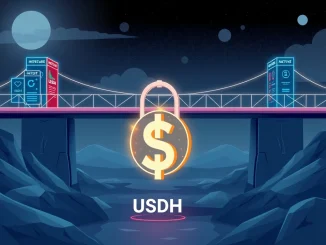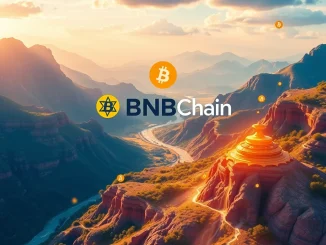
The crypto world is constantly evolving, and innovative fundraising strategies are emerging as a key differentiator for successful projects. At Consensus Hong Kong 2025, Zak Folkman, co-founder of World Liberty Financial (WLFI), a promising DeFi project, dropped a bombshell: WLFI intentionally bypassed traditional venture capital routes. Let’s dive into this exclusive reveal and understand why WLFI chose community empowerment over VC backing, and what it means for the future of crypto fundraising.
DeFi Project WLFI’s Bold Stance Against Venture Capital
In a candid discussion at Consensus Hong Kong, Folkman stated unequivocally that WLFI received “no support received from venture capital firms.” This wasn’t an oversight; it was a deliberate strategic decision. According to Odaily, Folkman described their token sale as primarily a “marketing effort.” But marketing with a powerful purpose – to forge unbreakable community ties.
Why would a DeFi project, especially one with ambitious goals, intentionally steer clear of venture capital? Here’s a breakdown of the potential reasons and implications:
- Decentralization at its Core: DeFi, by its very nature, champions decentralization. Relying heavily on VC funding can sometimes lead to centralized control and influence, potentially compromising the core ethos of a decentralized project. WLFI’s approach suggests a commitment to true decentralization, starting from its funding model.
- Community Empowerment: By focusing on a token sale as a community-building exercise, WLFI is prioritizing its user base from day one. This fosters a sense of ownership and shared purpose among token holders, creating a stronger and more resilient ecosystem.
- Avoiding VC Influence: Venture capital firms often come with expectations – timelines, specific ROI targets, and sometimes even influence over project direction. By opting out, WLFI retains greater autonomy and flexibility to pursue its vision without external pressures.
- Long-Term Vision: Building a strong community can be a more sustainable long-term strategy than relying solely on VC injections. A dedicated community can provide ongoing support, feedback, and organic growth for the project.
Navigating the Initial Investor Concerns: Cryptocurrency Fundraising in the Spotlight
Folkman openly acknowledged that the path wasn’t without its bumps. Retail investors initially voiced concerns regarding WLFI’s valuation and ambitious fundraising goals. Raising $1.2 billion through a token sale is no small feat, and skepticism is natural.
However, WLFI seems to have addressed these concerns head-on by:
- Transparency: By openly discussing the lack of VC funding and the rationale behind their token sale strategy, WLFI is demonstrating transparency, building trust with the community.
- Early Milestones: Folkman highlighted that WLFI achieved its milestones ahead of schedule. This tangible progress likely reassured investors and demonstrated the project’s capability to deliver on its promises.
- Focus on Utility and Governance: Positioning WLFI as both a governance and utility token underscores its intrinsic value beyond just speculative trading. Governance tokens empower the community to participate in decision-making, while utility tokens offer practical use cases within the WLFI ecosystem.
Token Sale Insights: Decoding the WLFI Cryptocurrency Fundraising Strategy
The numbers are indeed noteworthy. Reports indicate that approximately 24 billion WLFI tokens were sold at $0.05 each, amassing a staggering $1.2 billion. Let’s break down what this token sale signifies:
| Metric | Value |
|---|---|
| Tokens Sold | 24 Billion WLFI |
| Token Price | $0.05 |
| Total Funds Raised | $1.2 Billion |
This substantial raise, achieved without traditional VC, highlights the immense potential of community-driven cryptocurrency fundraising. It showcases that projects can achieve significant capital injection by directly engaging with their user base and offering them a stake in the project’s future.
WLFI Token: Utility and Governance – What’s in Store?
Folkman emphasized that WLFI serves a dual purpose: governance and utility. This is a common and increasingly popular model in the DeFi space. But what does this mean in practical terms?
- Governance: Holding WLFI tokens likely grants users voting rights on key decisions related to the WLFI project. This could include protocol upgrades, treasury management, and future development directions. Community governance is a cornerstone of decentralization, ensuring that the project evolves in a way that benefits its users.
- Utility: The utility aspect suggests that WLFI tokens will have practical applications within the WLFI ecosystem. While specific details weren’t provided in the report, utility could encompass various functions such as accessing premium features, reduced transaction fees, staking rewards, or participation in specific platform activities.
The combination of governance and utility aims to create a robust and self-sustaining token economy, incentivizing long-term holding and active participation within the WLFI community.
Cautionary Note: Navigating Unofficial Sources in the DeFi Space
With trading options, including swaps, not yet available for WLFI, Folkman issued a crucial warning: “cautioned against heeding unofficial sources.” This is vital advice in the often-unregulated and rapidly evolving DeFi landscape.
Here’s why being wary of unofficial sources is paramount:
- Scams and Misinformation: Unofficial channels can be breeding grounds for scams, fake token listings, and misleading information. Always rely on official project channels for accurate updates.
- Security Risks: Engaging with unofficial sources might expose you to phishing attempts or malicious links that could compromise your crypto assets.
- Inaccurate Information: Rumors and speculation can spread quickly in unofficial channels, leading to uninformed decisions and potential financial losses.
Always verify information through official WLFI channels and reputable crypto news sources to stay safe and informed.
Conclusion: A New Era for Cryptocurrency Fundraising?
WLFI’s decision to forgo venture capital and prioritize community funding is a fascinating development in the DeFi space. It raises important questions about the future of cryptocurrency fundraising and the evolving relationship between projects and their communities.
Key takeaways from WLFI’s approach:
- Community-First Funding: WLFI demonstrates the viability of large-scale fundraising driven by community participation, potentially reshaping how DeFi projects secure capital.
- Decentralization in Action: By avoiding VC, WLFI reinforces its commitment to decentralization, aligning its funding model with the core principles of DeFi.
- Empowering Retail Investors: The token sale model gives retail investors early access and ownership, democratizing investment opportunities in promising crypto projects.
- Transparency and Engagement: Open communication and proactive engagement with the community are crucial for building trust and navigating investor concerns.
While the long-term success of WLFI’s strategy remains to be seen, their bold move to champion community over traditional venture capital is undoubtedly a significant moment in the DeFi narrative, potentially paving the way for a more decentralized and community-centric future for crypto projects. Keep an eye on WLFI – they might just be pioneering a revolutionary approach to building and funding the next generation of DeFi innovations.



